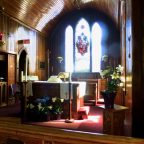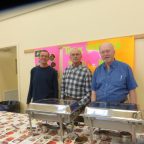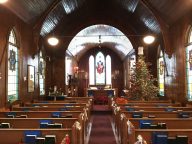March 19, 2017 sermon Lent 3
Living Water, Living Faith
We are taking the opportunity during Lent this year to reflect on what it means to us to be Christian people. One of the tools to help us with that this year is a prayer written by 13th century Bishop Richard of Chichester: “Day by day, dear Lord, three things I pray: to see thee more clearly; to love thee more dearly; to follow thee more nearly, day by day.”
As we remember this prayer, and as we pray it, it helps us reflect on these questions for Lent: What does it mean for us to see God more clearly? What does it mean for us to love God more dearly? What does it mean for us to follow Jesus more nearly?
This year, I have invited 4 people from our congregation to tell you about their faith. Two weeks ago, Joyce Aasland shared part of her journey as a Christian. Last week, Deacon Chris Ross challenged us (as only a deacon can) to live out our faith day by day in the world. This week, I invite Deb Saffin to reflect with us about her journey of faith.
X X X
Thank you, Deb.
I would like to reflect briefly on our gospel this morning. Like most of the stories in John’s gospel, it can be read on multiple levels. At its heart, it is a story about a life–giving relationship with God.
The story starts with Jesus breaking all the rules of polite society. He crosses boundaries. In that day, men didn’t speak with women to whom they were not related. And Jews certainly didn’t talk with Samaritans.
But here comes Jesus to the local watering place. He starts talking with a woman, a foreigner, a nobody. He takes the risk of talking to this woman
She’s had a tough life. She’s been shunned by the people in the village where she lives. She’s used to people treating her like dirt… but Jesus is different. He sees her. He really sees her. She is not invisible to him. Jesus treats her as a person who has value and worth. She is a daughter of God. He doesn’t condemn her; he recognizes that she has led a difficult and tragic life. And as he sees her, he opens the possibility of a relationship.
That raises a number of questions for me. Where are the watering places in our society? Where do people gather? Where might we meet with folks these days? And how can we learn to see them, so that we too might form relationships?
The conversation begins with water, but it quickly moves to another level. It becomes a conversation about faith and life. It becomes a conversation about spiritual hunger and thirst. Living water …
Again, some questions—what are people hungry and thirsty for these days? We only discover what it is for other people when we dare to get involved in a relationship with them. And what about us? What gives meaning in our lives?
Then the conversation becomes an invitation, After seeing her, after getting involved with her, Jesus invites her. If you only knew what I can offer you, you would ask me. I will give you living water. Open your heart, open your life, and your life will be made abundant by God’s powerful love. You will worship God in spirit and truth, and your hungers will be fed, your thirst will be quenched.
Some more questions—how has our hunger been fed? And once we’ve been fed, how might we offer that food, that living water to feed our neighbourhoods, our city, our world?
What does it mean to us to be a Christian? What are we hungry and thirsty for? How does your faith feed you?
In Lent, we reflect on what it means to us to be a Christian.
“Day by day, dear Lord, three things I pray: to see thee more clearly; to love thee more dearly; to follow thee more nearly, day by day.”
Thanks be to God.
Rev. Dr. Yme Woensdregt
March 19, 2017 (3rd Sunday in Lent)
John 4: 5–42
Exodus 17: 1–17
Romans 5: 1–11







